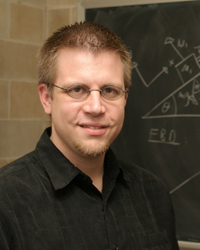
Recent experiments led by a Florida State University researcher provide a major step toward solving a two-decades-old materials-science mystery—and are shedding light on the mysteries of superconductivity.
Christopher Wiebe, an assistant professor of physics at FSU, and colleagues from the United States and Canada report that their research has made important progress toward the ultimate goal of creating new materials that are optimized for their magnetic and electrical properties. A paper describing their work is published in the online edition of the prestigious science journal Nature Physics; it can be accessed at www.nature.com/.
For nearly a century, scientists have known that many metals become "superconductors"— meaning they lose all electrical resistance and can conduct electric current endlessly—when exposed to very low temperatures. The application of this knowledge has led to such technological innovations as magnetic-levitation trains and magnetic resonance imaging, or MRI.
"Despite decades of research, a number of questions remain in our understanding of the physical processes involved in superconductivity," Wiebe said. "Our experiments provided rare glimpses into the complicated dance of electrons at very low temperatures. Hopefully these experiments will answer some of those questions and lead to even greater technological leaps."
A quest for understanding of the physical processes involved in superconductivity— specifically the behavior of electron pairs—has driven more than 20 years of condensed-matter physics research, because such knowledge could lead to the development of revolutionary technological devices.
In the project Wiebe participated in, an international team of researchers combined their efforts to find out what happens to electrons when cooled in a material known as URu2Si2, a uranium-based compound with superconductive properties. The properties of the compound were determined at FSU’s National High Magnetic Field Laboratory. Wiebe, FSU graduate student John Janik and their colleagues were able to pinpoint why certain anomalies were seen in property measurements by scattering neutrons using a state-of-the-art instrument called a Disk-Chopper Spectrometer, housed at the National Institute of Standards and Technology (NIST) in Gaithersburg, Md. The Disk-Chopper shoots a controlled beam of cold neutrons, generated by a nuclear reactor, at the URu2Si2 sample.
At roughly 256 degrees below zero Celsius, the once-nomadic electrons that had roamed freely about the compound’s atomic structure—and generated their own magnetic fields—behave in a more orderly and cooperative fashion. Physicists don’t know how or why this occurs. While the research in the Nature Physics paper does not answer those questions, it does offer important clues about the behavior of electrons. It also rules out many of the theories for the behavior presented so far, inching science toward an answer.
"Neutrons are remarkable probes of phenomena within solids," Wiebe said. "This work could not be possible without the support of the NIST and the collaboration with other national laboratories such as the magnet lab."
The National Science Foundation funds user programs at both the magnet lab and the Center for High Resolution Neutron Scattering at the NIST.
In addition to FSU, the magnet lab and the NIST, other participants in this research came from McMaster University in Hamilton, Ontario, Canada.
The National High Magnetic Field Laboratory develops and operates state-of-the-art, high-magnetic-field facilities that faculty and visiting scientists and engineers use for research. The laboratory is sponsored by the National Science Foundation and the state of Florida. To learn more, visit www.magnet.fsu.edu.




